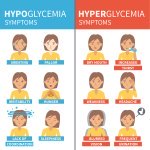Diet For Insulin Resistance

Understanding the cellular framework of insulin resistance helps us choose more effective and efficient therapeutic interventions for the treatment or prevention of prediabetes and type II diabetes. Insulin resistance is most times present in individuals who are obese and those with diabetes mellitus. Several scientific studies have discovered that an insulin resistance diet protocol and exercise can significantly alter insulin signaling pathways and delay the onset of insulin resistance in most cases.
It’s estimated that the number of diabetes mellitus sufferers in the world will double from about 180 million to 355 million during the next two decades. It’s obvious that we need to pay more attention to our lifestyle habits and make some necessary changes. An insulin resistance diet, which is quite similar to a diabetic diet plan, helps you lose excess weight and regulate your insulin and blood sugar levels in order to reduce your risk of developing prediabetes and diabetes.
The Best Diet for Insulin Resistance
Research suggests that the primary cause of insulin resistance in most cases is our modern western diet which is filled with sugar and simple carbohydrates which overwhelm the body and cause excess weight, especially excess fat around the waist.
Fortunately, minimizing the intake of simple carbohydrates which will naturally stabilize your blood sugar and lead to weight loss - can significantly help the body respond better to insulin.
There are hundreds of studies that show that a low carbohydrate or ketogenic diet will reverse metabolic diseases, reverse insulin resistance and even reverse diabetes.
Diet tips
Generally, it is best to adopt a lifestyle that focuses on whole, unprocessed foods and avoid highly processed and prepared foods. Foods that are highly processed, such as pasta, white bread, rice, and soda, digest very quickly and spike blood sugar levels significantly. They should be eliminated because they put unnecessary stress on your entire system.
Saturated fats from conventional beef and pork have also been associated with insulin resistance or prediabetes. This is primarily because animals store the toxins and hormones (like estrogen) that they are exposed to or injected with in their fat cells. High levels of estrogen alone are known to contribute to weight gain around the middle as well as diabetes and prediabetes. For this reason, you should consume only beef and pork from Organic or Free Range sources that have not been exposed to toxins or injected with hormones.
Here are some healthy foods that you can mix and match to create satisfying and delicious dishes for any meal.
Vegetables
One of the most important components of a diet for insulin resistance, vegetables are quite low in calories and very high in fiber, making them an ideal food for people trying to manage their blood sugar. The best options are fresh, low-sodium canned and frozen vegetables. Healthy options include spinach, colorful peppers, tomatoes, greens such as spinach, kale, and collard, and cruciferous vegetables such as cauliflower, broccoli, and Brussels sprouts. Vegetable juices may sometimes seem healthy, but they tend to be not as filling and aren’t as fibrous as fresh vegetables.
Dairy
Dairy offers you the calcium you need to help promote strong bones and teeth. Opt for full-fat, unsweetened yogurt and milk. If you are lactose intolerant, try unsweetened alternative milk like coconut and almond milk.
Fish
Fish that is loaded with the much needed omega-3 fatty acids can significantly reduce your risk of heart disease, a common condition for people with diabetes. Fish rich in omega-3 include:
• Salmon
• Rainbow trout
• Herring
• Mackerel
• Sardines
Tilapia, flounder, cod, halibut, and haddock are also good for you but lower in omega-3 since they are lower in total fat. Shellfish fans can enjoy scallops, shrimp, lobster, oysters, crabs, or clams as well. However, as with all kinds of foods, avoid fish that is fried or breaded. If you do choose to eat fried fish, make sure that it is cooked in a healthy oil.
Poultry
Protein such as Fish, Poultry, Beef and Pork are one of the most important components of a diet for insulin resistance. They should always be eaten with the fat on since that will ensure your blood sugar levels stay level. To keep your poultry consumption healthy, be sure to purchase organic or free range chicken. Consider eating duck, Cornish hen and turkey as well as chicken.
Grass Fed / Organic Meat
Grass fed protein such as veal, pork, lamb, and beef are vital to your diet for insulin resistance. Opt for pork tenderloin or center loins chops, veal loin chops or roasts, lamb chops, roast or legs, and all of the typical cuts of beef. For excellent health, consider branching out and eating some organ meats as well, just be sure that you are obtaining your meat from clean sources.
Healthy fats
A vital component of our diet for insulin resistance, choose healthy fat sources. Healthy fats like coconut oil, avocado oil, butter, and lard slow down digestion and offer essential fatty acids. They also hold up well under heat so they are good to cook with.
Seeds, nut and seed butter offer healthy fats, protein, magnesium, and fiber. Nuts and seeds are also very low in carbohydrates, which will be of benefits to anyone trying to manage their blood sugar. If you can, soak or sprout your nuts and seeds to minimize the antinutrients and phytic acid that are naturally present in them. This will make them much more digestible and prevent them from irritating your digestive tract.
Olives oil is wonderful, but since it is mono-saturated, it breaks down under heat. For this reason use it liberally in salads and other cold applications but do no cook with it.
Fruits
This is the least important component of a diet for insulin resistance. Fruit contains a lot of sugar, so eat it sparingly. Berries are the best because they contain a a lot of fiber and less sugar than stone fruits and melons. Munch on some fruit for fiber, minerals, and vitamins. Choose fresh or frozen fruits. Go for fruits that are higher in fiber, such as berries, peaches bananas, apple, grapes, and plums. Avoid fruit juices completely since they can will raise your blood sugar as quickly as regular soda.
Exercise
Regular exercise is essential re-sensitizing the cells of your body to insulin. This has to do with how our body stores and releases glucose. When you exercise, you flush all of the old insulin and glucose out of your body which helps your cells recognize that they need insulin to feed them glucose again. It is thru this mechanism that exercise helps prevent both insulin resistance and diabetes by lowering your blood sugar, using up body fat for energy, and significantly reducing weight. You really do not have to complete a triathlon to get fit. Anything that gets your body moving qualifies as exercise. Do something you enjoy such as gardening, running, walking, dancing or swimming.
Conclusion
getting diabetes. This diet combined with light exercise will help your cells become more sensitive to insulin. Please check our References Page to see all of the studies that support following a low carb or ketogenic diet for insulin resistance and reversing diabetes.



New! Facebook Comments
What do you think? Share your thoughts below...